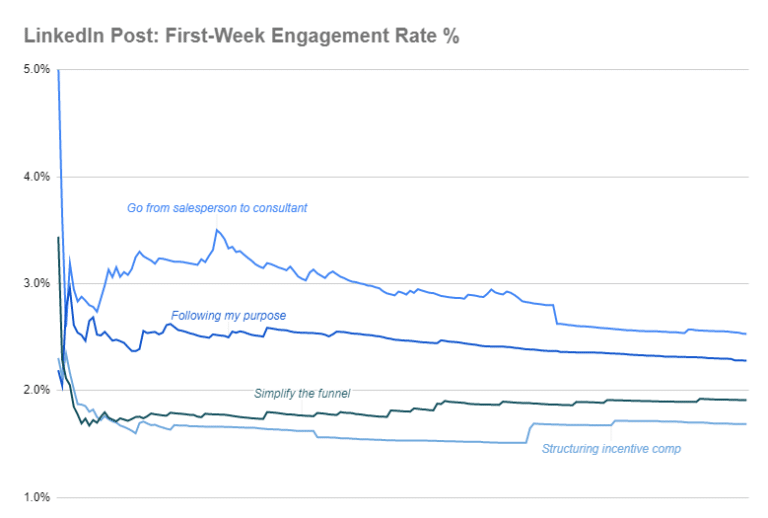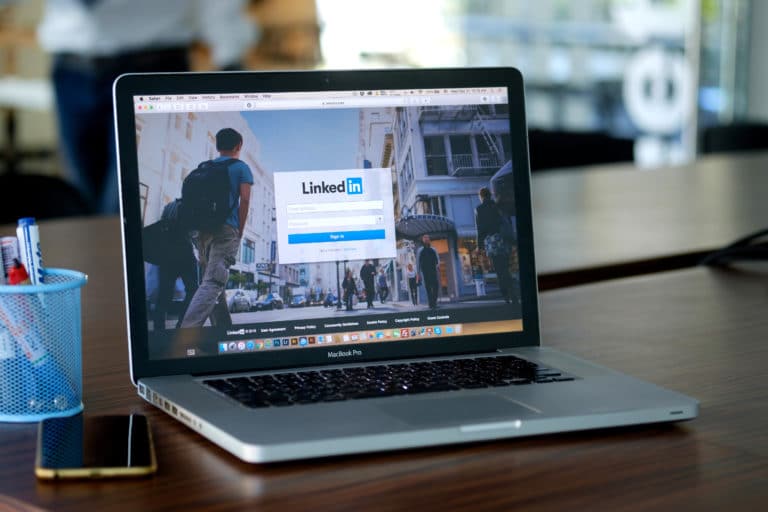LinkedIn is a powerhouse when it comes to B2B lead generation.
If your brand doesn’t have an active presence on the platform, you’re missing out on some massive opportunities to grow your brand and business.
However, success on LinkedIn is not just about signing up for an account and posting a few times.
To be successful on the platform, you must nail your LinkedIn outreach strategy.
And that’s exactly what we’ll be looking at in this post.
Why Should B2B Companies Use LinkedIn for Outreach?
Wondering why LinkedIn should be an integral part of your B2B marketing tools and campaigns?
Let’s look at a few reasons why:
Relevant Community
Boasting a community of close to 800 million professionals, you won’t find a better platform to promote your B2B products and services. Unlike other social media platforms, LinkedIn was designed specifically for professionals to network, making it easier for you to zero in on your target audience.
Better Conversion Rates
One primary reason LinkedIn users sign up for the platform is to use it to grow their business network. They want a place that will help them grow professionally and improve their organization’s performance. This makes for an audience that’s already primed for your offer.
Higher Quality Leads
Because LinkedIn users mean business, you’re bound to get higher quality leads on the platform. With a well-designed LinkedIn selling strategy, turning those leads into paying customers becomes a walk in the park (well, almost).
How To Launch A LinkedIn Outreach Campaign
Now that you know why LinkedIn is such an effective B2B marketing tool, let’s dive into how you can leverage it successfully.
1. Set Goals & KPIs
The first step to launching an effective LinkedIn outreach campaign is to set goals for the campaign and define your key performance indicators (KPIs). Some business marketing goals you can achieve with LinkedIn include, among others:
- Brand awareness
- Establishing thought leadership
- Lead generation
- Driving sales
Your goals determine the kind of campaign you’ll run. They’ll also help you define the most important KPIs for you to track. KPIs are measurable values used to gauge the performance of a campaign (or elements of a campaign) over time. These are usually tied to the goals you set. For example, you could set engagement metrics (like views, likes, and shares) as your brand awareness KPIs. Other KPIs you can track include conversion rates, click-through rates, follower growth rate, and more.
2. Use Sales Navigator to Build a List
If you haven’t yet signed up for LinkedIn Sales Navigator, now’s the time to do so. LinkedIn Sales Navigator is the paid version of the platform. It’s designed to be a sales management tool that enables sales teams to tap into LinkedIn’s extensive network more effectively. It features a set of tools designed to help you:
- Gain more visibility
- Create more meaningful connections
- Design personalized outreach campaigns
- Close more deals faster
To achieve all this, you need to build custom lists made up of an audience that’s more likely to be a fit for your product. With Sales Navigator, you can create lists according to the specific criteria you set. This allows you to filter out irrelevant contacts, leaving you with those that have a higher chance of converting.
Besides better conversions, Sales Navigator makes it easy to keep track of every lead you contact in a particular organization. This is important as you’ll probably have to reach out to and engage many different people on an organization’s buying committee.
3. Create Engagement Sequences
Successful outreach on LinkedIn is dependent on proving your expertise and building meaningful relationships. To get noticed, you need to come up with engagement sequences that will put you on your prospects’ radar.
What is an engagement sequence?
FYI, an engagement sequence is a strategic set of actions you take to interact with prospects to warm them up. An example of a simple engagement sequence could include:
- Liking their posts
- Leaving a comment
- Sending a connection request
- Giving an endorsement
- First direct message
Granted, it takes a bit of research to get to know your prospects well enough to ensure your engagement is personalized and effective. But it’s worth it as this increases the chances of your outreach campaign succeeding.
4. Write Copy Variations to Test
Once you’ve crafted your engagement sequences, it’s time to create copy for your first direct message. The purpose of your first message (which is usually a connection request) is two-fold — introducing yourself and showing the value your prospects will get from having you in their network.
As you craft that first message, a few things to remember include keeping it short, direct, and to the point. It’s also a great idea to include a call-to-action, so they show interest by responding.
For best results, create a few variations of your copy and test it. This will show you which version converts best.
5. Use Automation & Strategy
Successful LinkedIn outreach is a numbers game. The more inboxes you can reach, the higher your chances of generating more high-quality leads.
This is where automation and strategy come to play.
By employing a LinkedIn automation tool, you can scale your outreach whilst still maintaining personalization. You can also use a LinkedIn automation tool to collect email addresses from your custom lists.
However, you’ll have to be strategic about how you use automation. That’s because LinkedIn doesn’t endorse automation as they want to keep spam at bay. That’s why, when you use automation, you must ensure your tool can mimic human interaction as closely as possible. This means, among many other aspects, limiting the number of InMails you send in an hour.
Besides interaction, you must ensure that your messaging is as personalized as possible.
6. Monitor Engagement
Once you’ve launched your outreach campaign, you need to keep an eye on engagement. For example, if someone responds to an automated message, take the time to read it carefully and respond manually.
It’s also important to keep an eye on post engagement. People who engage with your posts show they’re interested in your brand and would make for good leads.
7. Follow Up
What do you do if a prospect doesn’t respond to your DM?
That’s one question many ask concerning using LinkedIn for B2B lead generation.
And the answer is quite simple — follow-up.
Remember, your prospects don’t know you well enough to say yes immediately. Instead, most will probably be wondering whether to trust you enough to take the relationship to the next level.
A well-crafted follow-up message can make a difference. It’s a great way to show prospects that you mean business. A few tips on sending effective follow-up messages include:
- Focus on what your prospect will benefit from you.
- Include social proof to build trust.
- Don’t resend the same message, always follow up with a different one.
Remember to be polite, state your purpose, and keep it as short as possible.
8. Evaluate Performance & Launch Improved Campaign
After your campaign has run its entire course, evaluate its performance using your goals and KPIs. Determine whether your campaign has been a success or not. Also, ascertain the parts of the campaign that could have been better.
Once the data has spoken, create an optimized iteration of your campaign and run it on a small segment of your prospect list as a test. If the new version gives you better results, run it on the rest of your prospect list. Then, at the end of the campaign, run the numbers again and use them to create a better campaign iteration. Keep doing this as this will ensure you’re running effective data-driven LinkedIn outreach campaigns.
Tips To Increase Your Effectiveness
There are a few tips you can implement to ensure yours are just that. Here are some we’ve seen work wonders for our campaigns (and those we run for clients).
Personalization
People respond better when they see you’ve taken the time to get to know them. That’s why you must tailor your messages for each of your prospects.
Concise & Clear Messages
LinkedIn users are busy. The moment they see a novella in their DMs, they’ll run and never give you a second chance.
Offer Something They Value Upfront
People always want to know what’s in it for them. That’s why you must offer something valuable upfront. Don’t pitch what you want, and then point to the offer.
Prove Your Worth
Why should your prospects trust you with their businesses and customers? Answer that question by including social proof (like case studies, reviews or testimonials) in your messages.
Use Engaging Visuals
Grab attention in the inbox by leveraging visual content like images and videos. Bonus points if you add a touch of personalization.
Signal Your Intentions Early
Again, people are busy and want to know the point of your message as quickly as possible. Therefore, signaling your intentions early is an excellent way to increase the effectiveness of your campaigns.
Have an Impressive Personal Profile
The first place your prospects go to when they want to know you better is your profile. That’s why it plays a significant role in your LinkedIn outreach campaign. And that’s why you must optimize it to impress, build trust, and clearly show who you are and what you do.
Following the LinkedIn outreach best practices outlined above is a great way to prime your campaigns for success.
Best Tools For LinkedIn Outreach
I’m sure by now you’re wondering how you can pull off an impactful LinkedIn outreach campaign at scale when there are so many moving pieces.
The simple answer is LinkedIn automation tools.
LinkedIn automation tools are software designed to help automate repetitive tasks on LinkedIn. These are tasks like:
- Connecting with prospects.
- Sending outreach messages.
- Endorsing your connections.
- Collecting data to help build effective campaigns.
The level and type of automation you’ll get are dependent on the type of tool you use.
So, what are some of the LinkedIn automation tools you should have in your toolbox?
SalesHub
SalesHub is a tool designed to help sales teams close more deals by sending hyper-personalized messages.
- Purpose: email collection, personalization, and advanced automation.
- Benefit: SalesHub enables you to create advanced high-impact outreach sequences that include personalized images.
With pricing starting at $49/month, SalesHub is one of the most affordable LinkedIn automation tools on the market.
Hyperise
Hyperise is one tool you need to add to your arsenal of LinkedIn automation tools as it helps you take personalization to a whole new level. This is all thanks to the dynamic personalization layers it enables you to add to images.
- Purpose: Image and video personalization.
- Benefit: Drive engagement with image personalization.
Hyperise’s lowest plan starts at $49/month.
Lempod
An integral part of success on LinkedIn is driving engagement through your posts. This is where a tool like Lempod comes in handy.
- Purpose: LinkedIn engagement.
- Benefit: Helps increase your thought leadership through higher visibility and engagement.
Lempod offers two pricing plans Marketplace ($5/pod) and Private Business Pod ($2/user in a pod).
Expandi
Expandi is a cloud-based tool touted as being the world’s safest LinkedIn automation tool.
- Purpose: Engagement and lead generation.
- Benefit: One of Expandi’s biggest benefits is the smart limits feature. This ensures your automated activity is as close to human interaction as possible.
Expandi comes with only one plan that will set you back $99/month.
Reply
Reply is a powerful sales engagement platform designed to help you reach your audience on many Reply is a powerful sales engagement platform designed to help you reach your audience through email outreach as well as other platforms, with LinkedIn being one of them.
- Purpose: Human-like interactions to improve your social selling.
- Benefit: Intuitive task flows that help improve the efficiency of your outreach.
For $70/month/user, Reply is an excellent tool that will help you beat your quotas.
LinkedIn Outreach for B2B Lead Generation — Time to Get Started
If you haven’t started leveraging LinkedIn for B2B lead generation, there’s no better time than now to start. With LinkedIn being the largest professional networking site around, the chances of you getting high-quality leads are higher.
But for the platform to work for you, you must understand how to run LinkedIn outreach campaigns the right way. Use the tips and tools outlined above to ensure that yours are effective — even at scale.
If you’re not confident in executing your own campaigns, feel free to reach out for our LinkedIn marketing services or start a free trial of Aware (our social selling software) today. We’ll help you design, execute, and automate LinkedIn outreach campaigns that will help your business and revenue grow exponentially.




